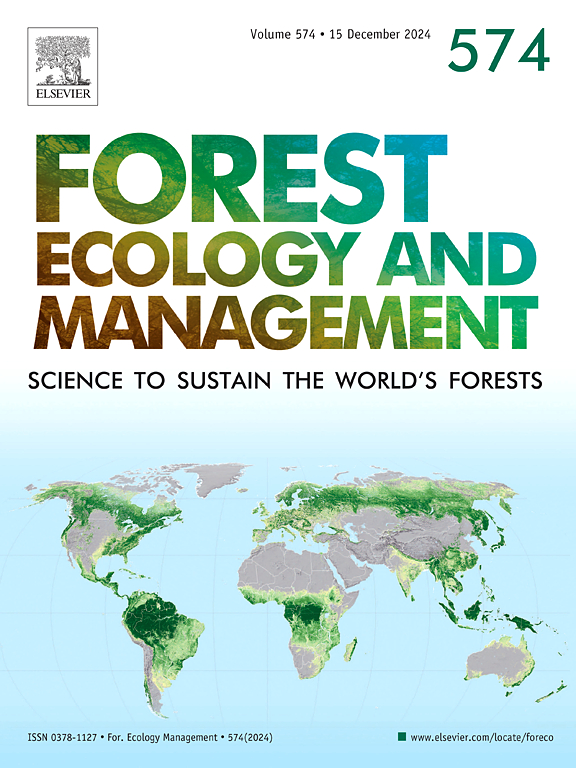与生态上不同的亲本物种相比,云杉杂交种显示出更优越的寿命增长,但对气候压力的反应却处于中等水平
IF 3.7
2区 农林科学
Q1 FORESTRY
引用次数: 0
摘要
气候变化带来了新的限制,树木必须适应,包括气候异常导致的更频繁的恶劣天气事件。黑云杉和红云杉在系统发育上接近,但适应不同的生态条件,形成了一个自然杂交带,它们的自然分布相互接触。因此,考虑到种间基因流动最终可能影响它们适应自然分布重叠的能力,它们代表了一个有趣的模型,可以研究气候变化背景下渐渗杂交的影响。通过收集20岁的后代树进行普通的花园田间试验,这些后代树是由严格控制的杂交(包括先前验证的亲本遗传身份)产生的,可以观察到物种之间以及它们与其F1杂交种之间的生长模式和木材密度差异。采用基于木芯的树木生态学分析方法,揭示了不同树种间木材对气候变化的相似响应,包括寿命期气候敏感性和偶发应力响应指数。然而,它们在黑云杉和红杉早、晚木材中的表达存在差异,这种差异可能是由于对不同生长季节长度的形成层物候适应差异所致。在试验场条件下,杂种F1在寿命累积生长方面表现出杂种优势,但在气候响应相关性状方面表现出中等优势。这些结果可能有助于森林遗传资源的管理,并有助于更好地了解杂交带对气候的适应动态。本文章由计算机程序翻译,如有差异,请以英文原文为准。
Spruce hybrids show superior lifespan growth but intermediate response to climate stress compared to their ecologically divergent parental species
Climate change brings new constraints to which trees will have to adapt, including more frequent severe weather events due to climate anomalies. Black spruce and red spruce are phylogenetically close but adapted to different ecological conditions, and they form a natural hybrid zone where their natural distributions come into contact. Thus, they represent an interesting model to study the effect of introgressive hybridization in the context of climate change, given that interspecific gene flow could eventually affect their capacity to adapt where their natural distributions overlap. Using a common garden field test gathering 20-year-old progeny trees resulting from rigorous controlled crosses including previously verified genetic identity of the parents, growth patterns and wood density differences could be observed between species and between them and their F1 hybrids. A dendroecological analytical approach relying on wood cores was used and revealed similar wood responses to climatic variations between species, both through lifespan climate sensitivity and through episodic stress response indexes. They were however differentially expressed in early- and latewood between black spruce and red spruce, differences likely driven by diverging cambial phenology adaptations to different growing season lengths. F1 hybrids exhibited hybrid vigor for lifespan cumulative growth under the test site conditions but showed intermediate values for traits related to climate response. These results may assist the management of forest genetic resources and contribute to a better understanding of the dynamics of adaptation to climate in hybrid zones.
求助全文
通过发布文献求助,成功后即可免费获取论文全文。
去求助
来源期刊

Forest Ecology and Management
农林科学-林学
CiteScore
7.50
自引率
10.80%
发文量
665
审稿时长
39 days
期刊介绍:
Forest Ecology and Management publishes scientific articles linking forest ecology with forest management, focusing on the application of biological, ecological and social knowledge to the management and conservation of plantations and natural forests. The scope of the journal includes all forest ecosystems of the world.
A peer-review process ensures the quality and international interest of the manuscripts accepted for publication. The journal encourages communication between scientists in disparate fields who share a common interest in ecology and forest management, bridging the gap between research workers and forest managers.
We encourage submission of papers that will have the strongest interest and value to the Journal''s international readership. Some key features of papers with strong interest include:
1. Clear connections between the ecology and management of forests;
2. Novel ideas or approaches to important challenges in forest ecology and management;
3. Studies that address a population of interest beyond the scale of single research sites, Three key points in the design of forest experiments, Forest Ecology and Management 255 (2008) 2022-2023);
4. Review Articles on timely, important topics. Authors are welcome to contact one of the editors to discuss the suitability of a potential review manuscript.
The Journal encourages proposals for special issues examining important areas of forest ecology and management. Potential guest editors should contact any of the Editors to begin discussions about topics, potential papers, and other details.
 求助内容:
求助内容: 应助结果提醒方式:
应助结果提醒方式:


